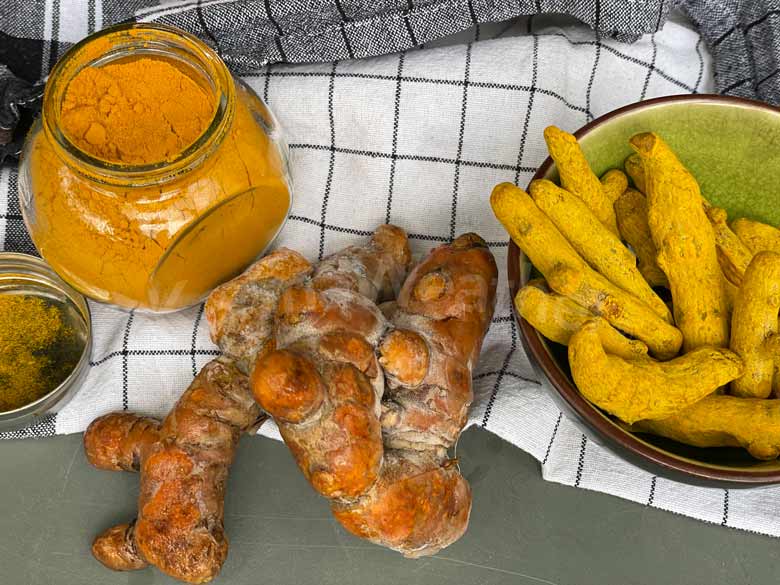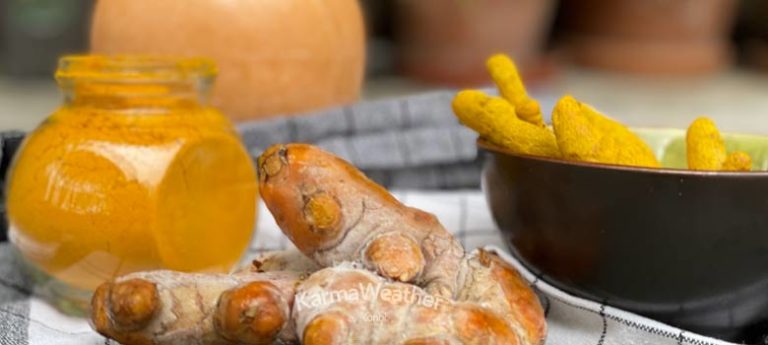Turmeric: A Golden Spice with Great Healing Powers
© KarmaWeather by Konbi - All rights reserved
Meaning, powers and uses of Turmeric
Explore the many facets of Turmeric - its role in health, its uses in traditional medicine, and its magical properties. Learn what makes this spice a powerful ally in wellbeing.
Turmeric, derived from the plant Curcuma longa, is a vibrant yellow-orange spice commonly known as the "golden spice". Its roots are ground into a fine powder that is a fundamental ingredient in many Asian cuisines, especially Indian, where it’s an essential part of curries and other spicy dishes. Beyond its culinary significance, turmeric possesses potent therapeutic powers. It is a revered element of traditional medicine systems like Ayurveda and Traditional Chinese Medicine, where it has been used for millennia to treat a variety of ailments. Additionally, turmeric carries cultural significance in several religions and magical practices.
| Turmeric's magic powers | Luck | 🍀🍀🍀 | |
|---|---|---|---|
| Love | - | Protection | 🛡🛡🛡 |
| Healing, purification | 🌿🌿🌿 | Parapsychic | - |
| Exorcism | - | Money | - |
| Power, success | - | Fertility | 🐣🐣🐣 |
| Sexual desire | - | Chastity | - |
Turmeric: Technical sheet
Popular names: Turmeric, Haldi, Haridra, Indian Saffron
Latin name: Curcuma longa
Origin: South Asia and Southeast Asia
Color: Deep Orange (root), White to pink (flower), Green (leaves)
Description: Turmeric is a perennial plant of the ginger family, evident by the similar structure of its root (rhizome). It is native to South Asia and Southeast Asia, and it requires a significant amount of rainfall and temperatures between 20°C and 30°C to prosper. Turmeric plants typically reach up to one meter in height and have long, oblong leaves. Its rhizomes, the main source of the spice, are tuberous with a rough, brown skin. The interior of the rhizomes is deep orange and hard. It's most recognized when ground into a fine, golden-yellow powder.
Culinary and dietary uses: Turmeric is a staple spice in many Asian cuisines, especially Indian, where it is a key ingredient in curries. It also adds color and flavor to rice dishes, lentils, and stews. Turmeric's deep orange pulp is concealed beneath a rough, brown outer layer. Upon grinding, it produces a distinctive, vibrant golden powder. Its flavor is described as warm, slightly peppery, and bitter, while its aroma carries hints of mustard, ginger, and orange. Turmeric is often consumed as a tea or in capsules as a dietary supplement. Its bioactive compound, curcumin, carries a host of potential health benefits, including anti-inflammatory and antioxidant properties.
Turmeric: Nutrition facts, health benefits
Please read disclaimer notice at the bottom of the page.
Calories (energetic value): 1500 kJ (357 kcal)
Protein: 7.83 g (per 100 g)
Main vitamins: Vitamin C (43 % of Daily Value), Vitamin B6 (55 % DV)
Main minerals: Iron (219 % DV), Manganese (340 % DV)
Health properties: Turmeric is rich in dietary fiber, vitamin B6, vitamin C, and various minerals such as manganese, iron, and potassium. However, its most valuable component is a powerful bioactive compound called curcumin. Curcumin is an antioxidant with potent anti-inflammatory effects. It helps combat oxidative damage and chronic inflammation, two factors implicated in various diseases like heart disease, cancer, Alzheimer's, and various degenerative conditions. Several studies suggest that curcumin may enhance brain function, improve arthritis symptoms, and potentially delay aging and fight age-related chronic diseases. Moreover, curcumin might aid digestion and alleviate symptoms of depression and anxiety. Please note that most of these benefits require curcumin intake significantly higher than a typical diet would provide.
Aromatherapy, phytotherapy: In aromatherapy, turmeric oil is used to help reduce stress, anxiety, and promote emotional well-being. In phytotherapy, turmeric is used to help with digestive disorders, skin diseases, and liver conditions.
Benefit for skin: Turmeric is known for its anti-inflammatory and antioxidant benefits for the skin. It can improve skin health by reducing acne, boosting skin glow, and potentially reducing the appearance of wrinkles.
Possible side effects: Turmeric is generally considered safe in food amounts. However, high doses or long-term use may cause side effects like nausea, diarrhea, and stomach upset. Individuals with gallbladder disease or those taking blood-thinning medications should use turmeric with caution.
The Wonders of Turmeric: From Kitchen Spice to Health Ally
Main virtues and magic powers of Turmeric

Turmeric: Astrological, traditional, magical properties
Gender: Female
Planet, deity: Mars, Sun
Vedic element: Fire
Related chakra: Solar Plexus Chakra (Manipura)
Zodiac sign, moon sign: Aries
Chinese element: Fire
Chinese zodiac sign: Dragon
Ayurveda, traditional medicine: In Ayurveda, turmeric is revered for its ability to balance the three doshas: vata, pitta and kapha, as well as cleansing the chakras (energy centers). It is used in treating a variety of conditions, including skin diseases, respiratory illnesses, and liver disorders.
Psychological benefits: Turmeric has potential psychological benefits due to its compound curcumin. It's shown promise in boosting mood and combatting symptoms of depression and anxiety, possibly due to its anti-inflammatory properties that impact brain function.
Magical uses: In magical practices, turmeric is believed to offer protection, purification, and fertility. It's often used in protective amulets and spells and is thought to ward off evil spirits and negative energy. In the realm of astrology, turmeric is associated with the Sun and Mars, symbolizing vitality, energy, courage, and protection. It is thought to carry the warming properties of the sun, stimulating the physical body and invigorating the spirit.
Did you know? Turmeric has been used as a dye due to its vibrant yellow color. It has been used for centuries in Indian clothing and even today is used in preparing the bright yellow robes of Buddhist monks.
